An official website of the United States government
 United States Department of Labor
United States Department of Labor
Guide or control vehicular or pedestrian traffic at such places as streets, schools, railroad crossings, or construction sites.
Employment estimate and mean wage estimates for Crossing Guards and Flaggers:
| Employment (1) | Employment RSE (3) |
Mean hourly wage |
Mean annual wage (2) |
Wage RSE (3) |
|---|---|---|---|---|
| 82,690 | 2.9 % | $ 17.15 | $ 35,670 | 1.0 % |
Percentile wage estimates for Crossing Guards and Flaggers:
| Percentile | 10% | 25% | 50% (Median) |
75% | 90% |
|---|---|---|---|---|---|
| Hourly Wage | $ 11.53 | $ 13.78 | $ 15.12 | $ 18.83 | $ 23.91 |
| Annual Wage (2) | $ 23,990 | $ 28,660 | $ 31,450 | $ 39,160 | $ 49,720 |
Industries with the highest published employment and wages for Crossing Guards and Flaggers are provided. For a list of all industries with employment in Crossing Guards and Flaggers, see the Create Customized Tables function.
Industries with the highest levels of employment in Crossing Guards and Flaggers:
| Industry | Employment (1) | Percent of industry employment | Hourly mean wage | Annual mean wage (2) |
|---|---|---|---|---|
| Local Government, excluding schools and hospitals (OEWS Designation) | 35,740 | 0.67 | $ 16.70 | $ 34,740 |
| Other Support Services | 28,290 | 10.07 | $ 17.57 | $ 36,550 |
| Elementary and Secondary Schools | 7,470 | 0.09 | $ 14.78 | $ 30,750 |
| Employment Services | 2,710 | 0.08 | $ 17.08 | $ 35,520 |
| Highway, Street, and Bridge Construction | 2,280 | 0.64 | $ 19.76 | $ 41,090 |
Industries with the highest concentration of employment in Crossing Guards and Flaggers:
| Industry | Employment (1) | Percent of industry employment | Hourly mean wage | Annual mean wage (2) |
|---|---|---|---|---|
| Other Support Services | 28,290 | 10.07 | $ 17.57 | $ 36,550 |
| Local Government, excluding schools and hospitals (OEWS Designation) | 35,740 | 0.67 | $ 16.70 | $ 34,740 |
| Highway, Street, and Bridge Construction | 2,280 | 0.64 | $ 19.76 | $ 41,090 |
| Utility System Construction | 1,240 | 0.23 | $ 22.81 | $ 47,450 |
| Investigation and Security Services | 2,030 | 0.22 | $ 15.82 | $ 32,910 |
Top paying industries for Crossing Guards and Flaggers:
| Industry | Employment (1) | Percent of industry employment | Hourly mean wage | Annual mean wage (2) |
|---|---|---|---|---|
| Other Heavy and Civil Engineering Construction | 50 | 0.04 | $ 32.46 | $ 67,520 |
| Colleges, Universities, and Professional Schools | 60 | (7) | $ 28.00 | $ 58,240 |
| Support Activities for Water Transportation | (8) | (8) | $ 27.91 | $ 58,050 |
| Electric Power Generation, Transmission and Distribution | (8) | (8) | $ 26.52 | $ 55,160 |
| Building Equipment Contractors | (8) | (8) | $ 24.71 | $ 51,410 |
States and areas with the highest published employment, location quotients, and wages for Crossing Guards and Flaggers are provided. For a list of all areas with employment in Crossing Guards and Flaggers, see the Create Customized Tables function.
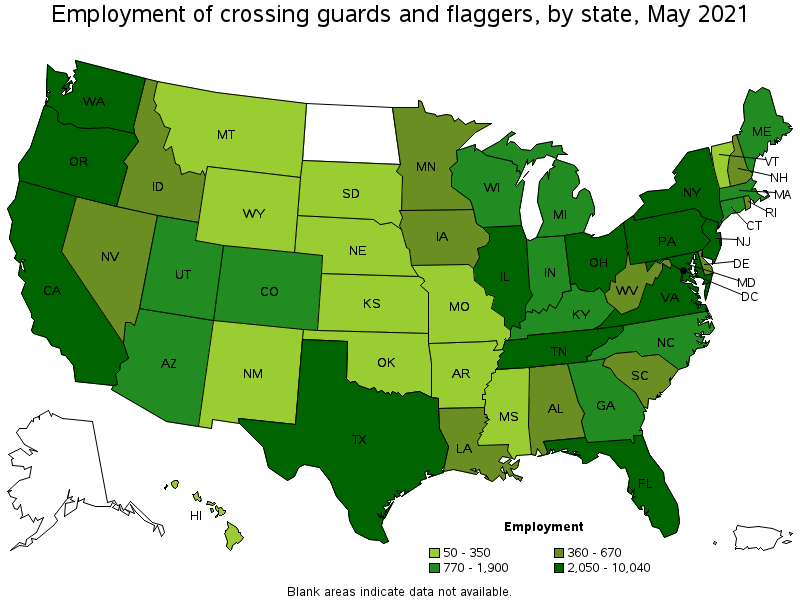
States with the highest employment level in Crossing Guards and Flaggers:
| State | Employment (1) | Employment per thousand jobs | Location quotient (9) | Hourly mean wage | Annual mean wage (2) |
|---|---|---|---|---|---|
| New York | 10,040 | 1.16 | 1.97 | $ 19.01 | $ 39,550 |
| Pennsylvania | 7,510 | 1.35 | 2.29 | $ 17.68 | $ 36,770 |
| Texas | 7,110 | 0.58 | 0.99 | $ 13.08 | $ 27,200 |
| California | 4,990 | 0.30 | 0.51 | $ 22.41 | $ 46,600 |
| Florida | 4,860 | 0.56 | 0.96 | $ 14.65 | $ 30,470 |
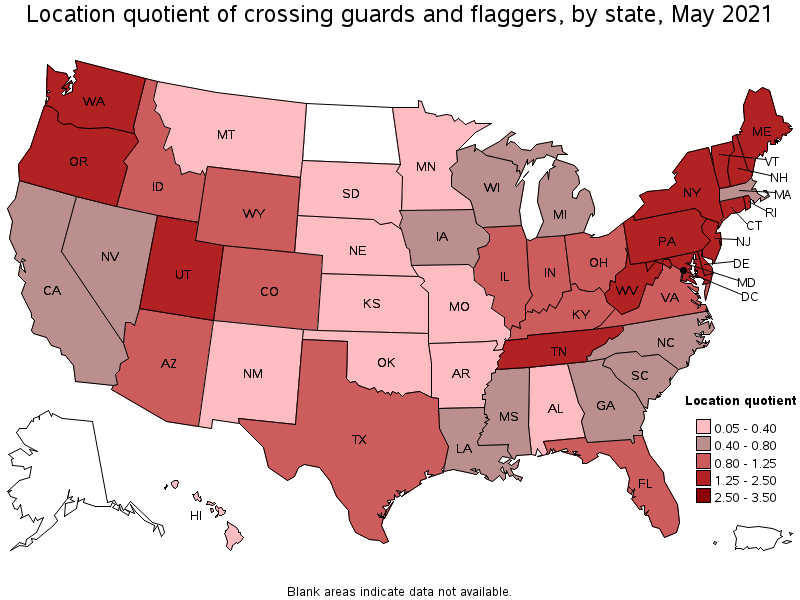
States with the highest concentration of jobs and location quotients in Crossing Guards and Flaggers:
| State | Employment (1) | Employment per thousand jobs | Location quotient (9) | Hourly mean wage | Annual mean wage (2) |
|---|---|---|---|---|---|
| Pennsylvania | 7,510 | 1.35 | 2.29 | $ 17.68 | $ 36,770 |
| Maine | 770 | 1.29 | 2.20 | $ 15.19 | $ 31,590 |
| Vermont | 350 | 1.24 | 2.12 | $ 17.80 | $ 37,020 |
| Utah | 1,900 | 1.22 | 2.08 | $ 14.97 | $ 31,130 |
| New Jersey | 4,580 | 1.19 | 2.03 | $ 18.37 | $ 38,220 |
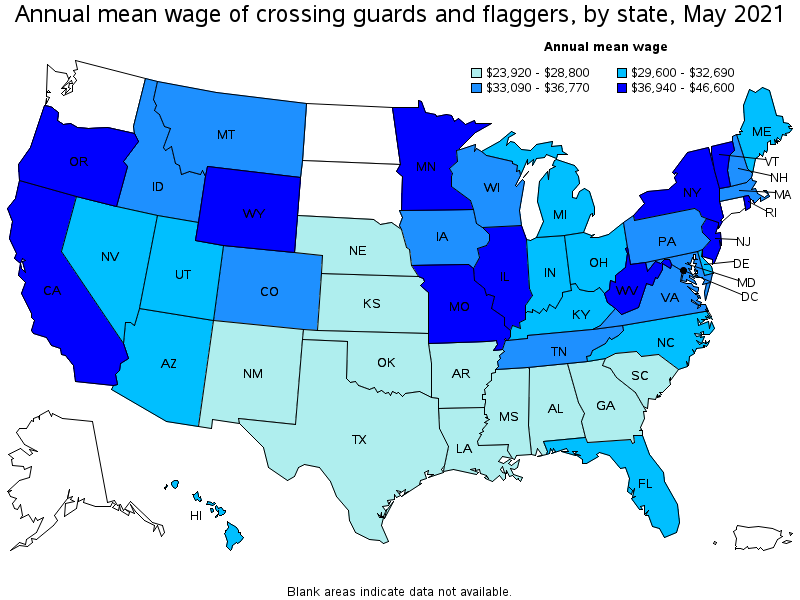
Top paying states for Crossing Guards and Flaggers:
| State | Employment (1) | Employment per thousand jobs | Location quotient (9) | Hourly mean wage | Annual mean wage (2) |
|---|---|---|---|---|---|
| California | 4,990 | 0.30 | 0.51 | $ 22.41 | $ 46,600 |
| Rhode Island | 390 | 0.86 | 1.47 | $ 21.01 | $ 43,700 |
| Oregon | 2,050 | 1.12 | 1.91 | $ 20.20 | $ 42,020 |
| District of Columbia | 360 | 0.55 | 0.93 | $ 19.97 | $ 41,550 |
| Illinois | 2,810 | 0.50 | 0.85 | $ 19.93 | $ 41,440 |
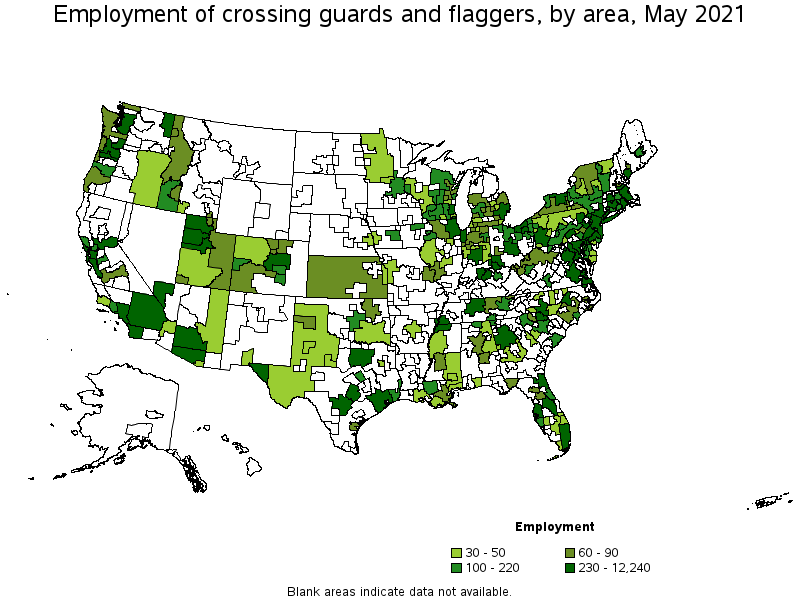
Metropolitan areas with the highest employment level in Crossing Guards and Flaggers:
| Metropolitan area | Employment (1) | Employment per thousand jobs | Location quotient (9) | Hourly mean wage | Annual mean wage (2) |
|---|---|---|---|---|---|
| New York-Newark-Jersey City, NY-NJ-PA | 12,240 | 1.41 | 2.40 | $ 19.10 | $ 39,730 |
| Philadelphia-Camden-Wilmington, PA-NJ-DE-MD | 2,870 | 1.08 | 1.84 | $ 18.03 | $ 37,500 |
| Chicago-Naperville-Elgin, IL-IN-WI | 2,580 | 0.61 | 1.04 | $ 20.29 | $ 42,210 |
| Dallas-Fort Worth-Arlington, TX | 2,280 | 0.63 | 1.08 | $ 13.06 | $ 27,160 |
| Seattle-Tacoma-Bellevue, WA | 2,140 | 1.12 | 1.90 | $ 23.90 | $ 49,720 |
| Houston-The Woodlands-Sugar Land, TX | 1,860 | 0.64 | 1.09 | $ 14.71 | $ 30,590 |
| Pittsburgh, PA | 1,820 | 1.74 | 2.97 | $ 17.39 | $ 36,180 |
| Washington-Arlington-Alexandria, DC-VA-MD-WV | 1,700 | 0.58 | 0.99 | $ 19.06 | $ 39,640 |
| Miami-Fort Lauderdale-West Palm Beach, FL | 1,510 | 0.62 | 1.05 | $ 15.76 | $ 32,780 |
| Memphis, TN-MS-AR | 1,450 | 2.40 | 4.09 | $ 15.59 | $ 32,420 |
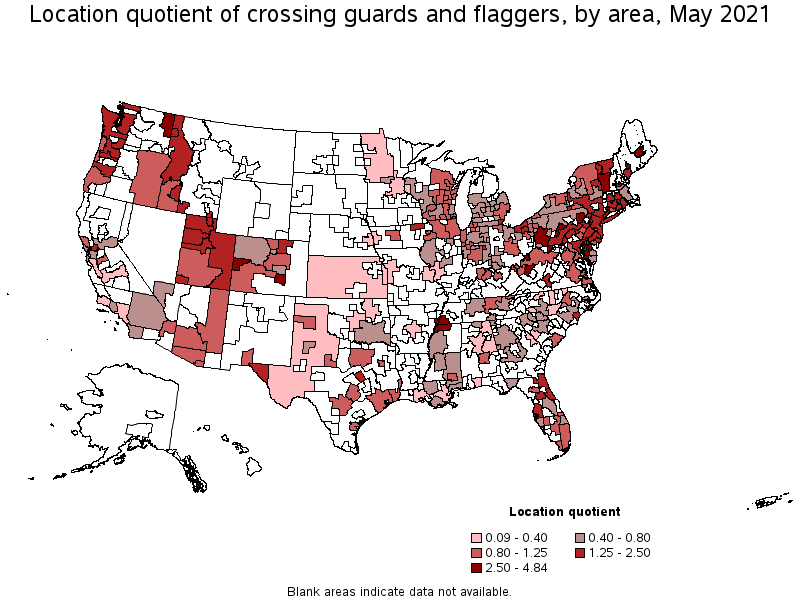
Metropolitan areas with the highest concentration of jobs and location quotients in Crossing Guards and Flaggers:
| Metropolitan area | Employment (1) | Employment per thousand jobs | Location quotient (9) | Hourly mean wage | Annual mean wage (2) |
|---|---|---|---|---|---|
| Grand Junction, CO | 180 | 2.84 | 4.84 | $ 15.67 | $ 32,600 |
| Memphis, TN-MS-AR | 1,450 | 2.40 | 4.09 | $ 15.59 | $ 32,420 |
| Altoona, PA | 130 | 2.37 | 4.04 | $ 14.38 | $ 29,910 |
| Dover, DE | 140 | 2.14 | 3.65 | $ 14.18 | $ 29,500 |
| Parkersburg-Vienna, WV | 70 | 2.01 | 3.43 | $ 14.28 | $ 29,700 |
| Lewiston-Auburn, ME | 90 | 1.91 | 3.26 | $ 14.30 | $ 29,740 |
| Waterbury, CT | 120 | 1.89 | 3.21 | $ 15.77 | $ 32,800 |
| Spokane-Spokane Valley, WA | 440 | 1.87 | 3.19 | $ 22.36 | $ 46,520 |
| Bangor, ME | 110 | 1.85 | 3.14 | $ 15.77 | $ 32,800 |
| State College, PA | 120 | 1.81 | 3.08 | $ 18.61 | $ 38,700 |
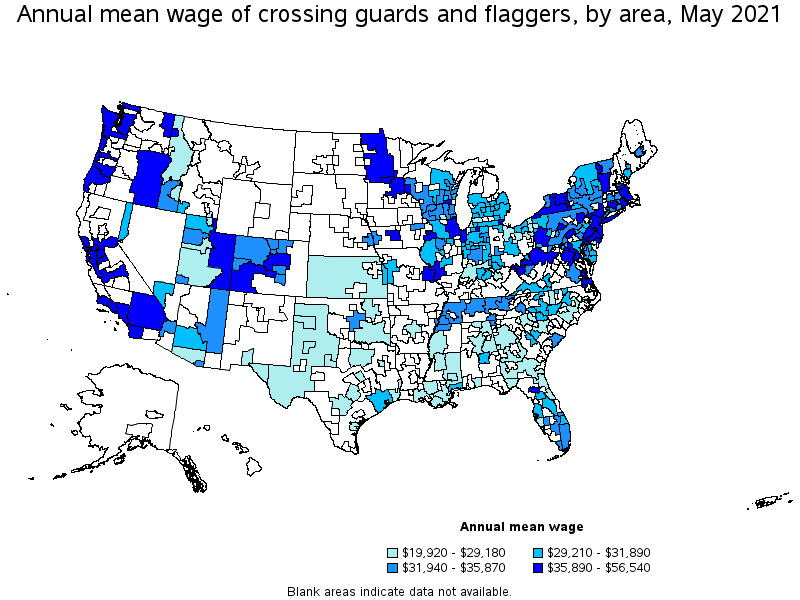
Top paying metropolitan areas for Crossing Guards and Flaggers:
| Metropolitan area | Employment (1) | Employment per thousand jobs | Location quotient (9) | Hourly mean wage | Annual mean wage (2) |
|---|---|---|---|---|---|
| San Francisco-Oakland-Hayward, CA | 770 | 0.35 | 0.59 | $ 27.18 | $ 56,540 |
| Sacramento--Roseville--Arden-Arcade, CA | 390 | 0.40 | 0.68 | $ 26.86 | $ 55,860 |
| Bellingham, WA | 60 | 0.73 | 1.25 | $ 26.38 | $ 54,870 |
| Fond du Lac, WI | 30 | 0.70 | 1.20 | $ 25.05 | $ 52,110 |
| Oxnard-Thousand Oaks-Ventura, CA | 110 | 0.37 | 0.63 | $ 24.18 | $ 50,290 |
| Seattle-Tacoma-Bellevue, WA | 2,140 | 1.12 | 1.90 | $ 23.90 | $ 49,720 |
| Santa Maria-Santa Barbara, CA | 30 | 0.17 | 0.29 | $ 23.63 | $ 49,140 |
| Fresno, CA | 80 | 0.22 | 0.38 | $ 23.62 | $ 49,120 |
| Hartford-West Hartford-East Hartford, CT | 600 | 1.10 | 1.87 | $ 23.37 | $ 48,600 |
| Gainesville, FL | 70 | 0.51 | 0.86 | $ 23.14 | $ 48,130 |
Nonmetropolitan areas with the highest employment in Crossing Guards and Flaggers:
| Nonmetropolitan area | Employment (1) | Employment per thousand jobs | Location quotient (9) | Hourly mean wage | Annual mean wage (2) |
|---|---|---|---|---|---|
| Southern Vermont nonmetropolitan area | 190 | 1.98 | 3.37 | $ 18.21 | $ 37,880 |
| Southern Pennsylvania nonmetropolitan area | 140 | 0.78 | 1.33 | $ 17.19 | $ 35,760 |
| Central East New York nonmetropolitan area | 110 | 0.74 | 1.26 | $ 16.33 | $ 33,970 |
| South Central Wisconsin nonmetropolitan area | 110 | 0.55 | 0.94 | $ 15.95 | $ 33,180 |
| North Northeastern Ohio nonmetropolitan area (noncontiguous) | 100 | 0.31 | 0.53 | $ 13.30 | $ 27,660 |
Nonmetropolitan areas with the highest concentration of jobs and location quotients in Crossing Guards and Flaggers:
| Nonmetropolitan area | Employment (1) | Employment per thousand jobs | Location quotient (9) | Hourly mean wage | Annual mean wage (2) |
|---|---|---|---|---|---|
| Southern Vermont nonmetropolitan area | 190 | 1.98 | 3.37 | $ 18.21 | $ 37,880 |
| Maryland nonmetropolitan area | 100 | 1.69 | 2.88 | $ 16.26 | $ 33,810 |
| Northwestern Idaho nonmetropolitan area | 60 | 0.84 | 1.44 | $ 12.90 | $ 26,840 |
| Northern Vermont nonmetropolitan area | 50 | 0.81 | 1.39 | $ 17.16 | $ 35,690 |
| Southern Pennsylvania nonmetropolitan area | 140 | 0.78 | 1.33 | $ 17.19 | $ 35,760 |
Top paying nonmetropolitan areas for Crossing Guards and Flaggers:
| Nonmetropolitan area | Employment (1) | Employment per thousand jobs | Location quotient (9) | Hourly mean wage | Annual mean wage (2) |
|---|---|---|---|---|---|
| Western Washington nonmetropolitan area | 90 | 0.75 | 1.28 | $ 25.77 | $ 53,600 |
| Eastern Oregon nonmetropolitan area | 40 | 0.60 | 1.02 | $ 23.02 | $ 47,870 |
| Northern West Virginia nonmetropolitan area | 90 | 0.66 | 1.12 | $ 21.77 | $ 45,280 |
| Coast Oregon nonmetropolitan area | 70 | 0.63 | 1.08 | $ 19.98 | $ 41,560 |
| Southern Vermont nonmetropolitan area | 190 | 1.98 | 3.37 | $ 18.21 | $ 37,880 |
These estimates are calculated with data collected from employers in all industry sectors, all metropolitan and nonmetropolitan areas, and all states and the District of Columbia. The top employment and wage figures are provided above. The complete list is available in the downloadable XLS files.
The percentile wage estimate is the value of a wage below which a certain percent of workers fall. The median wage is the 50th percentile wage estimate—50 percent of workers earn less than the median and 50 percent of workers earn more than the median. More about percentile wages.
(1) Estimates for detailed occupations do not sum to the totals because the totals include occupations not shown separately. Estimates do not include self-employed workers.
(2) Annual wages have been calculated by multiplying the hourly mean wage by a "year-round, full-time" hours figure of 2,080 hours; for those occupations where there is not an hourly wage published, the annual wage has been directly calculated from the reported survey data.
(3) The relative standard error (RSE) is a measure of the reliability of a survey statistic. The smaller the relative standard error, the more precise the estimate.
(7) The value is less than .005 percent of industry employment.
(8) Estimate not released.
(9) The location quotient is the ratio of the area concentration of occupational employment to the national average concentration. A location quotient greater than one indicates the occupation has a higher share of employment than average, and a location quotient less than one indicates the occupation is less prevalent in the area than average.
Other OEWS estimates and related information:
May 2021 National Occupational Employment and Wage Estimates
May 2021 State Occupational Employment and Wage Estimates
May 2021 Metropolitan and Nonmetropolitan Area Occupational Employment and Wage Estimates
May 2021 National Industry-Specific Occupational Employment and Wage Estimates
Last Modified Date: March 31, 2022